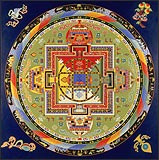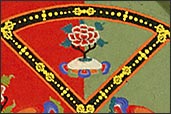 |
A mandala represents an invitation to enter the Buddha's awakened mind. Tibetan Buddhists believe there is a seed of enlightenment in each person's mind that can be uncovered by visualizing and contemplating a mandala. The complex symbols and exquisite combination of primary colors are considered a pure expression of the principles of wisdom and compassion that underlie Tantric Buddhist philosophy.
 |

A mandala, or circle, is a representation of the Buddhist universe. These cosmograms represent in symbolic color, line, and geometric forms, all realms of existence and are used in Tantric meditation and initiation rites. |
 |

The Yamantaka Mandala is a cosmic blueprint of the celestial palace of the deity Yamantaka, Conqueror of Death. Discover the symbolism and meaning of the Yamantaka Mandala. |


Follow the process of the making of a mandala from preparation to creation to preservation |
 |


Read about Tibet's history and culture, and the monks' 1991 visit to The Minneapolis Institute of Arts |


How did this object come to be a part of the museum collection? Get the technical details about the Mandala's preservation |


Watch the creative process and consecration ceremony in this short video documentary |

|
 |